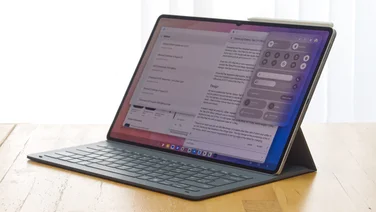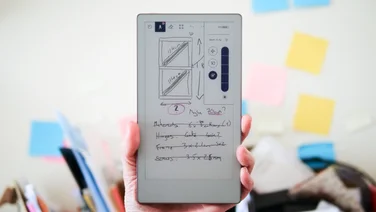To help us provide you with free impartial advice, we may earn a commission if you buy through links on our site. Learn more
- Huawei MatePad Paper review: What you need to know
- Huawei MatePad Paper review: Price and competition
- Huawei MatePad Paper review: Design and key features
- Huawei MatePad Paper review: Display and stylus
- Huawei MatePad Paper review: Writing and note-taking
- Huawei MatePad Paper review: Software and user interface
- Huawei MatePad Paper review: Verdict














- M-Pencil is responsive
- Sharp, edge-lit E Ink display
- Ebook app not fit for purpose
- Audio recording impacts responsiveness
- Disappointing battery life
E-readers don’t quite generate the excitement they once did, so manufacturers have been racking their brains to re-invigorate our interest. The answer, according to Huawei at least, is to take the humble e-reader, make it bigger and add a stylus, thus turning it into a digital notepad.
To be completely fair, Huawei isn’t the first to try this approach. That ground was well and truly broken by the reMarkable and then the reMarkable 2, a product we’re big fans of here at Expert Reviews.
The MatePad Paper, however, is altogether less successful. Although as you’ll soon read in this review, this is due mainly to its software rather than its hardware design.
Huawei MatePad Paper review: What you need to know
Outwardly, the Huawei MatePad Paper has everything it needs to take on the reMarkable 2. It has a large edge-lit 10.3in, 1,872 x 1,404 resolution touch-enabled E Ink display and stylus compatibility.
It comes with Huawei’s M-Pencil stylus in the box and you also get a smart folio cover for your money – both things you have to pay extra for if you invest in a reMarkable device.
Inside, there’s 64GB of storage, which is enough to store thousands upon thousands of pages of notes – enough that you’ll never need to buy another notepad ever again – and it comes with features the reMarkable can’t offer, such as the ability to record sound and play it back.
You can even use the MatePad Paper like a tablet to install third-party apps and browse the web, although the slow refresh of the E Ink display doesn’t lend itself well to most apps, nor is it a particularly slick browsing experience.
Huawei MatePad Paper review: Price and competition
At €500 (around £420), the Huawei MatePad Paper looks like an expensive product compared with traditional e-readers, but in the context of stylus-enabled tablets, it’s in the right sort of ballpark. The regular Apple iPad is £319 (plus £99 for the stylus) and is a much more capable device, although it doesn’t offer the same kind of battery life or paper-like feel.














The real competitor for the MatePad Paper, though, is the reMarkable 2. Like the Huawei device, it’s designed as a digital notepad and it’s also pretty expensive at £339 plus an extra £59 or £109 for a stylus.
The reMarkable, however, is a much more restrictive device. You can’t install third-party apps on it, record audio or directly annotate PDFs and ebooks.
Huawei MatePad Paper review: Design and key features
On the features front, it looks as if the Huawei MatePad Paper has the reMarkable 2 beaten. Especially as with much of Huawei’s hardware portfolio, the MatePad Paper is an attractively made device.
It’s slim (6.7mm) and light (360g) and feels solidly made. The 10.3in E Ink display at the front is surrounded by suitably narrow bezels, with the “spine” of the device on the left adding an extra half centimetre or so. A wrapping of leather-effect plastic means it’s a lot less like a phone or tablet in the hand and feels much more like a book or tablet.
The power button in the top-right-hand corner also doubles as a fingerprint reader, with a volume rocker just around the corner on the right, and the speaker grille and USB-C port on the bottom. This can be used for either charging or data transfer, which is useful if you want to transfer a PDF file and can’t be bothered fiddling around with cloud storage.
READ NEXT: Best Kindle
Huawei MatePad Paper review: Display and stylus
The E Ink display is sharp – it certainly should be given the 1,872 x 1,404 resolution – and it has an adjustable light that means you can read and take notes in the dark. However, it’s the feel and responsiveness of the pen on the display that’s more important for this device and Huawei has definitely nailed that aspect.














Not only does digital ‘ink’ appear instantly and with very little lag as you write, but the feel of the stylus’ nib on the screen is also just right: the nib slides smoothly over the surface of the screen but there’s a small amount of friction, which means the stylus isn’t slipping around uncontrollably.
And while it doesn’t quite have the uncannily real pen-on-paper feel that the reMarkable 2 does, it is superior to most stylus/tablet combos I’ve used over the years.
Huawei MatePad Paper review: Writing and note-taking
Taking notes on the MatePad Paper is a straightforward, even enjoyable affair. Once you unlock the device, you’re faced with a simple widget-based home page with Calendar, Notes, Inbox and Huawei Books being the default options. Yes, you can even sync your email and calendar with this thing if you want to.
You add a new note by simply tapping the plus symbol on the Notes widget and this opens up a new note with lined ‘paper’, ready for you to start jotting. You can opt for other paper types if you like, with nine options under the “Templates” menu option.
There’s also a small selection of pen types to choose from as well. You can go with the default Ball pen or opt for Fountain pen, Pencil or Marker. Each pen has three thickness options and three “colours”: black, grey and white. The latter might sound bizarre but it comes in handy when annotating images and other darker objects. And you can erase jottings by selecting the Eraser tool from the toolbar or double-tapping the barrel of the M-Pencil.














It’s even possible to record audio while you take notes, and you can select sections of your handwritten notes and convert them to typed text for copying and pasting elsewhere. On the subject of handwriting recognition, once you’ve written and saved a note, the MatePad scans it and converts it anyway, meaning you can then search for notes, not only by their titles but also what you’ve written in them.
This is one of the big advantages of digital note-taking devices like the MatePad Paper. Alongside the ability to store thousands of pages of notes, once you’ve written something down, you’ll be able to locate it quickly and painlessly thereafter. I found the recognition worked pretty reliably most of the time, too, and was even able to successfully convert my terribly spidery handwriting.
READ NEXT: Kindle Paperwhite review
Huawei MatePad Paper review: Software and user interface
Simply writing down your thoughts on digital paper and storing them, however, is just one aspect of the world of digital note-taking. Being able to back up those notes to keep them safe and share them between devices is another. Alas, this is where the MatePad Paper’s offering begins to fall apart.
Although you can upload files to your Huawei Drive individually (or OneDrive after installing the app), email them and send them to other devices via Bluetooth and Wi-Fi Direct, there seems to be no way to automatically synchronise or back up notes to cloud storage. Despite linking my Huawei ID and Mobile Cloud account to the device, all the notes made on the MatePad remained steadfastly on the device.
It turns out that there’s a simple explanation for this. As Huawei explained to me, the Notes app on the MatePad Paper and the Notepad app on Huawei’s phones are separate pieces of software and so notes don’t synchronise between the two. Huawei said it was working on providing the option to download the phone Notepad app onto the MatePad Paper in future, but this doesn’t fix the problem of not being able to easily access notes written in the MatePads Notes app on other devices.
That’s isn’t a complete dealbreaker but it isn’t great. And there are plenty of other problems, too. The ability to record audio into your notes and add bookmarks as you go is useful but tapping the Record icon degrades performance so much that writing on the MatePad entirely loses its feeling of responsiveness. Until Huawei fixes that, it’s a completely useless feature.














And while the Huawei MatePad Paper allows you to effortlessly annotate PDF files and ebooks, there are issues with this as well. Again, the process of scribbling your notes in the margins works fine; the trouble arises when you want to do anything with those scribbles once you’ve made them.
There is, for instance, no easy way of searching through annotations as they aren’t automatically converted to searchable text which is odd considering regular notes are searchable. And, while you can browse your annotations, finding what you need quickly is difficult since the MatePad lists notes by a series of page thumbnails and not by any closer context. I’d have hoped for something a little cleverer than that.
If you were wondering if the MatePad Paper would make a good large-format e-reader, I’m afraid in its current state it doesn’t succeed. Mainly this is because of a rather daft oversight: Huawei’s ebook software breaks lines in the middle of words without discretion (even short words such as ‘as’ ‘the’ and ‘but’) and is completely unhyphenated.
You can circumvent this issue by side-loading the Kindle app and logging in to your Amazon account, but then you lose the ability to scribble on your books with the stylus. Let’s hope this little snafu is one the developers can fix fairly easily before Huawei begins to ship the product in the UK.
Alas, there’s no getting around the final problem: battery life. Even with intermittent use, I found myself having to charge the MatePad Paper once every two to three days, which to put it mildly is woefully short for an E Ink device.
Huawei MatePad Paper review: Verdict
There’s no sidestepping the uncomfortable truth here: the Huawei MatePad Paper is not a product you should buy in its current form. Although the hardware impresses in some respects – the M-Pencil and screen work well for note-taking when you’re not recording audio and the screen is nice and sharp – the software is plainly not ready for prime time.
More thought needs to be put into how annotations and notes are organised, and synchronisation needs to work better; in fact, it needs to just work. The ebook reader app is badly in need of an update to prevent it putting line breaks in the middle of words like ‘and’ and ‘the’. And it would be nice if you could use the audio-recording facility without the whole thing slowing performance to a crawl.
I like the idea of the MatePad Paper, and it does offer more in the way of features than its main rival, but at a price of around £400 I’m afraid I can’t possibly recommend it when it feels so unfinished. If you like the idea of a digital notepad – and it does have some merit for those who take lots of handwritten notes – do yourself a favour and buy a reMarkable 2 instead.






